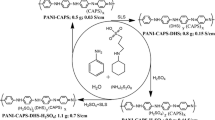Abstract
Several polyaniline, PANI, samples were inverse emulsion polymerized by doping two surfactants. Experimentally, the triton X-100, TX100, was always used and another surfactant was varied as sodiumlauryl sulfate, SLS, sodium dodecyl sulfonate, SDS, or 5-sulfosallcylic acid dehydrate, SSA, respectively. To compare with the pure or only TX100-doped PANI, the PANI doped by two surfactants all showed enhanced conductivity and thermal stability, e.g. the PANI/TX100+SSA presented the greatest conductivity and the PANI/TX100+SDS presented the best thermal stability. The conductivity enhancement is found due to the doping induced PANI crystallinity increase. The thermal stability increase for PANI is found due probably to the surfactant structure because the symmetric double bonded structure, e.g. SDS and SLS, both showed better thermal behavior.






Similar content being viewed by others
References
Patil AO, Heeger AJ, Wud F (1988) Optical properties of conducting polymers. Chem Rev 88:183
Gospodinova N, Terlemezyan L (1998) Conducting polymers prepared by oxidative polymerization: polyaniline. Prog Polym Sci 23:1443
Palaniappan S, John A (2008) Polyaniline materials by emulsion polymerization pathway. Prog Polym Sci 33:732
Huang WS, Humphrey BD, MacDiarmid AG (1986) Syntheses and applications of conducting polymer polyaniline nanofibers. J Chem Soc Faraday Trans 82:2385
MacDiarmid AG, Epstein A (1989) Polyanilines: a novel class of conducting polymers. J Faraday Discuss Chem Soc 88:317
Urbach B, Korbakov N, Bar-David Y, Yitzchaik S, Saar A (2007) Composite structures of polyaniline and mesoporous silicon. J Phys Chem C 111:16586
Harlev E, Gulakhmedova T, Rubinovich I, Aizenshtein G (1996) A new method for the preparation of conductive polyaniline solutions: application to liquid crystal devices. Adv Mater 8:994
Anderson MR, Mattes BR, Reiss H, Kaner RB (1991) Conjugated polymer films for gas separations. Science 252:1412
Bhadra S, Chattopadhyay S, Singha NK, Khastgir D (2007) Effect of different reaction parameters on the conductivity and dielectric properties of polyaniline synthesized electrochemically and modeling of conductivity against reaction parameters through regression analysis. J Polym Sci B 45:2046
Bhadra S, Singha NK, Khastgir D (2008) Mechanical, dynamic mechanical, morphological, thermal behavior and processability of polyaniline and ethylene 1-octene based semi-conducting composites. Eur Polym J 44:1763
Dong JQ, Shen Q (2009) Enhancement in solubility and conductivity of polyaniline with lignosulfonate modified carbon nanotube. J Polym Sci B 47:2036
Dong JQ, Shen Q (2012) Comparison of the properties of PANI doped by lignosulfonates with three different ions. J Appl Polym Sci 126(S1):E10
Fu GD, Li GL, Neoh KG, Kang ET (2011) Hollow polymeric nanostructures-synthesis, morphology and function. Prog Polym Sci 36:127
Wan MX (2008) A template-free method towards conducting polymer nanostructures. Adv Mater 20:2926
Stejskal J, Omastova M, Fedorova S, Prokes J, Trchova M (2003) Polyaniline and polypyrrole prepared in the presence of surfactants: a comparative conductivity study. Polymer 44:1353
Kinlen PJ, Frushour BG, Ding Y, Menon V (1999) Synthesis and characterization of organically soluble polyaniline block copolymers. Synth Met 101:758
Palaniappan S (2002) Preparation of polyaniline-sulfate salt by emulsion and aqueouspolymerization pathway without using protonic acid. Polym Adv Technol 13:54
Xia H, Wang Q, Xia H, Wang Q (2001) Synthesis and characterization of conductive polyaniline nanoparticles through ultrasonic assisted inverse microemulsion polymerization. J Nanoparticle Res 3:401
Rao PS, Subrahmanya S, Sathyanarayana DN (2002) Inverse emulsion polymerization: a new route for the synthesis of conducting polyaniline. Synth Met 128:311
Rao PS, Sathyanarayana DN, Palaniappan S (2002) Polymerization of aniline in an organic peroxide system by the inverted emulsion process. Macromolecules 35:4988
Gong XY, Liu J, Baskaran S, Voise RD, Young JS (2000) Surfactant-assisted processing of carbon nanotube/polymer composites. Chem Mater 12:1049
Vaidyaa SG, Rastogi S, Aguirre A (2010) Surfactant assisted processable organic nanocomposite dispersions of polyaniline-single wall carbon nanotubes. Synth Met 160:134
Ayad M, El-Hefnawy G, Zaghlol S (2013) Facile synthesis of polyaniline nanoparticles; its adsorption behavior. Chem Eng J 217:460
Ichinohe D, Arai T, Kise H (1997) Synthesis of soluble polyaniline in reversed micellar systems. Synth Met 84:75
Bhadra S, Khastgir D, Singha NK, Lee JH (2009) Progress in preparation, processing and applications of polyaniline. Prog Polym Sci 34:783
Shioi A, Hatton TA (2002) Model for formation and growth of vesicles in mixed anionic/cationic (SOS/CTAB) surfactant systems. Langmuir 18:7341
Zhou DH, Li YH, Wang JY, Xu P, Han XJ (2011) Synthesis of polyaniline nanofibers with high electrical conductivity from CTAB–SDBS mixed surfactants. Mater Lett 65:3601
Fan L, Guo R (2008) Growth of dendritic silver crystals in CTAB/SDBS mixed-surfactant solutions. Cryst Growth Des 8:2150
Chen CF, Lei IA, Chiu WY (2012) Mixed-surfactant-induced morphology change of polyaniline. J Appl Polym Sci 126:E195
Saravanan C, Palaniappan S, Chandezon F (2008) Synthesis of nanoporous conducting polyaniline using ternary surfactant. Mater Lett 62:882
Girija TC, Sangarranarayanan MV (2006) Polyaniline-based nickel electrodes for electrochemical supercapacitors—influence of triton X-100. J Power Sources 159:1519
Gu ZJ, Wang JT, Li LL, Chen LF, Shen Q (2014) Formation of polyaniline nanotubes with different pore shapes using α-, β- and γ-cyclodextrins as templates. Mater Lett 117:66
Gu ZJ, Ye JR, Song W, Shen Q (2014) Synthesis of polyaniline nanotubes with controlled rectangular or square pore shape. Mater Lett 121:12
Gu ZJ, Zhang QC, Shen Q (2015) Synthesis and comparison of polyaniline nanofibers templated by α-, β- and γ-cyclodextrins. J Polym Res 22(2):1–4
Prathap MUA, Thakur B, Sawant SN, Srivastava R (2012) Synthesis of mesostructured polyaniline using mixed surfactants, anionic sodium dodecylsulfate and non-ionic polymers and their applications in H2O2 and glucose sensing. Colloids Surf B 89:108–116
Acknowledgement
This work was funded by Donghua University for undergraduate researching project on fabrication of PANI.
Author information
Authors and Affiliations
Corresponding author
Rights and permissions
About this article
Cite this article
Zhang, QC., Zhi, YY., Hu, EJ. et al. Fabrication and characterization of polyaniline by doping TX100-based two surfactants. J Polym Res 22, 93 (2015). https://doi.org/10.1007/s10965-015-0745-z
Received:
Accepted:
Published:
DOI: https://doi.org/10.1007/s10965-015-0745-z




